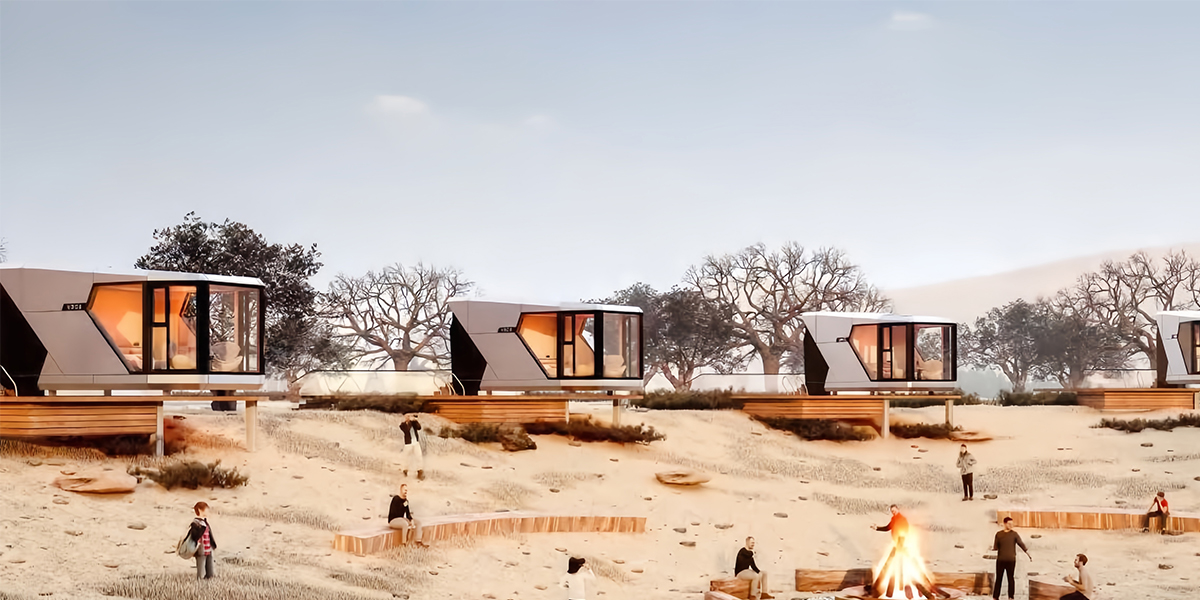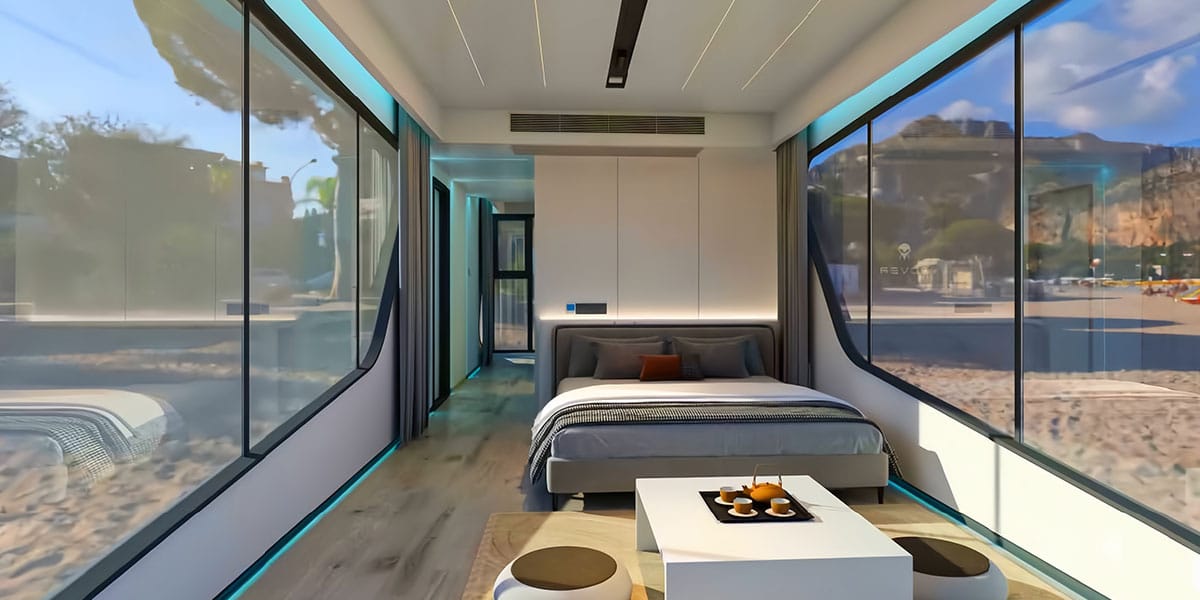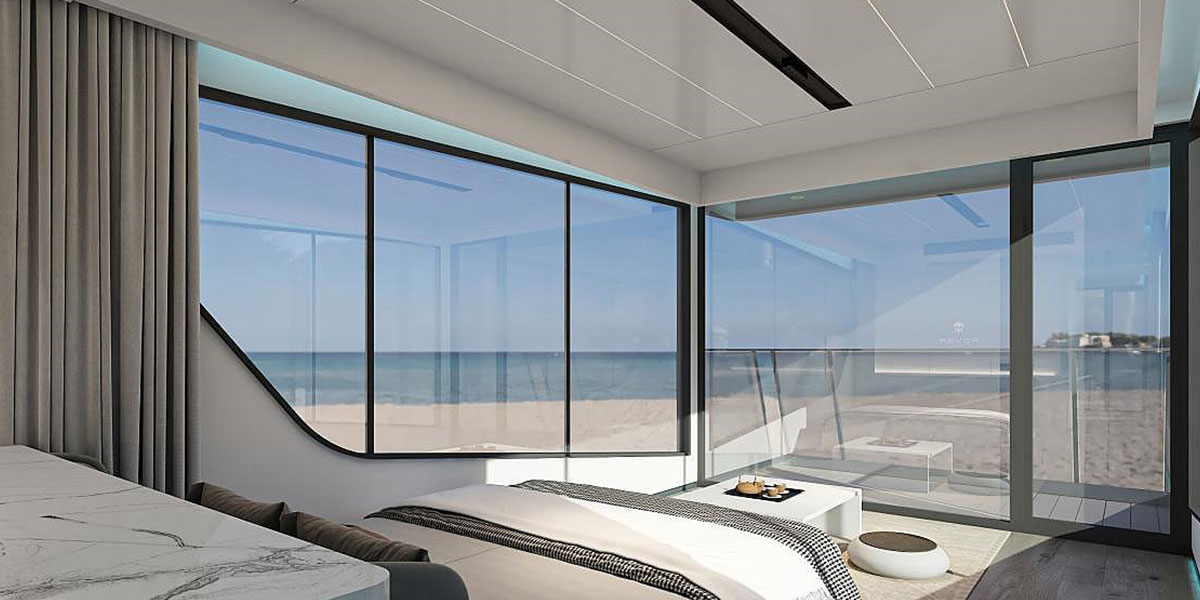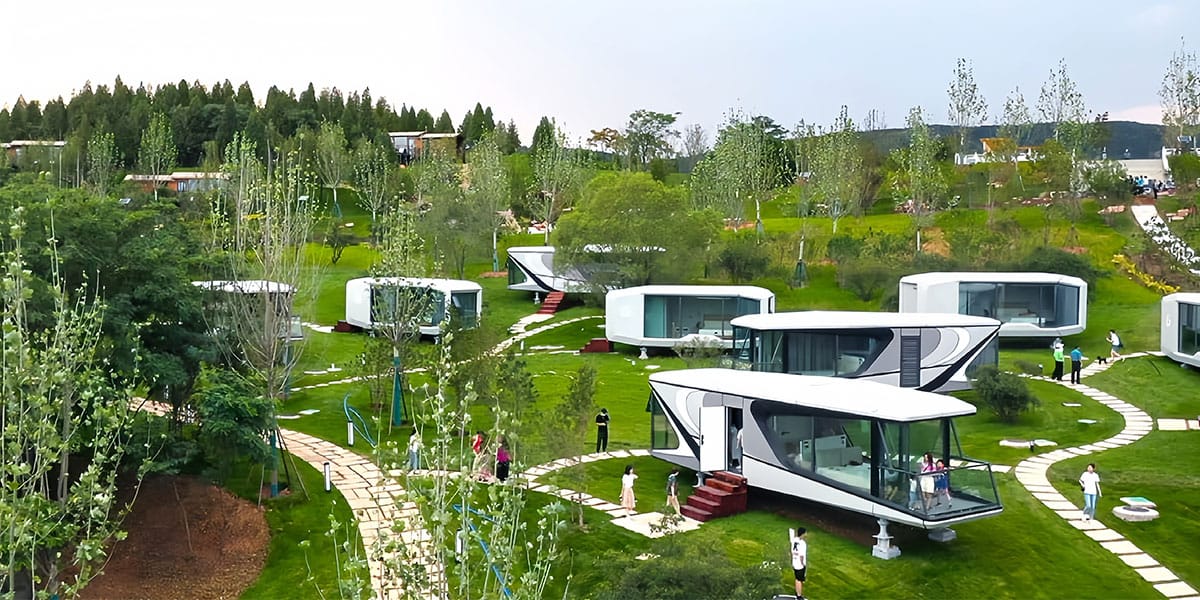
16 Jul Top Tips for Designing an Eco-Friendly Capsule House
Table of Contents
Living green doesn’t mean giving up comfort or style. Capsule house design is a smart way to live eco-friendly. Their small size uses less energy, making them great for tiny home fans. You can change the capsule house design to fit your needs and help the planet. Solar panels can generate up to 250 Wh of power daily. Fixing leaks or using better appliances saves water and money. Small actions can make big differences. Your capsule house can help build a greener future.
Key Takeaways
- Capsule houses save energy, using 65% less than normal homes. Good insulation and special windows keep your home warm and lower costs.
- Use renewable energy like solar panels to power your home. This helps the planet and saves money in the long run.
- Pick eco-friendly materials like recycled wood and safe paints. These are better for nature and make your home healthier.
- Use smart gadgets to control energy use. Tools like smart thermostats and monitors save money and cut waste.
- Create spaces that serve many purposes and use modular furniture. This makes your small home useful and cool-looking.
Energy Efficiency in Capsule House Design
Making capsule houses energy-efficient is a smart way to live green. Using less energy lowers bills, reduces pollution, and keeps your home cozy. Here are some simple ways to make your capsule house energy-smart.
Thermal Insulation for Better Energy Use
Insulation is key to saving energy in small homes. It keeps heat inside during winter and blocks it in summer. This means less need for heaters or air conditioners. Materials like foam with special microcapsules work well. They help keep temperatures steady and save energy.
Study Title | Findings |
|---|---|
Experimental and numerical analysis of the thermal performance of polyurethane foams panels incorporating phase change material | Adding PCMs improves insulation, making it ideal for green buildings. |
Thermal Stability and Flame Retardancy of Rigid Polyurethane Foam Composites Filled with Phase-Change Microcapsule | Microcapsules boost insulation and help manage heat better. |
Flame retardancy of rigid polyurethane foams containing thermoregulating microcapsules with phosphazene-based monomers | Microcapsules make foam safer from fire and improve insulation. |
Capsule houses use 65% less energy than regular homes. They are tightly sealed to stop heat from escaping. Good insulation makes your home comfy and saves energy.
Energy-Saving Windows and Doors
Windows and doors affect how much energy your home uses. Old windows let heat escape, wasting energy. New energy-saving windows stop drafts and keep heat inside. Look for windows with low U-factor and SHGC ratings. These block heat and keep your home cool.
Benefits of energy-efficient windows and doors:
- Lower energy bills by keeping heat in.
- Smaller, cheaper heating and cooling systems.
- Save $200–$400 each year on energy costs.
Choosing the right windows and doors makes your home energy-smart and comfy all year.
Renewable Energy Integration
Why depend only on the grid when you can use the sun? Solar panels can power your capsule house easily. They produce up to 250 Wh daily, perfect for small homes. Some designs even make more energy than they use.
Combine solar panels with natural airflow for best results. Place windows and vents to let air move freely. This cuts down on air conditioning use. Hybrid systems mix solar power with ventilation to keep homes cool.
Using renewable energy cuts pollution and saves money over time. It’s a smart, green choice for capsule houses.
Smart Technology for Energy Management
Smart tech makes saving energy simple in your capsule house. It helps you spend less, waste less, and live greener. These devices work on their own to manage energy for you.
Why Smart Technology Matters
Think about your home changing the temperature by itself. Smart systems do this based on weather or your routine. They learn what you do and adjust to save energy. For example, a smart thermostat lowers heat when you’re asleep or away. This keeps your home cozy and your bills low.
Tip: Use smart gadgets with energy-saving appliances for big savings. A smart plug can turn off unused devices. A smart fridge cools less when the door stays closed.
Real-Life Impact of Smart Technology
Smart tech isn’t just handy—it cuts energy use a lot. Here’s how it works:
Insight | Description |
|---|---|
Resident Behavior | Smart systems learn your habits to save energy and keep you comfy. |
Experts use smart tools to lower costs and help the planet. | |
Participation in Energy Management | You save more energy by setting schedules for smart devices. |
These systems need your help to work best. Set timers for lights or appliances to save even more energy.
Must-Have Smart Devices for Your Capsule House
Here are smart gadgets to make your capsule house eco-friendly:
- Smart Thermostats: Change heating and cooling based on your schedule.
- Smart Lighting: Turn off or dim lights when you leave a room.
- Energy Monitoring Systems: Show how much energy you use and ways to save.
- Smart Plugs: Stop power to devices not being used.
These tools work together to save energy and money. You’ll see lower bills and help the planet.
The Future of Smart Living
Smart tech keeps getting better. New gadgets will make homes even smarter. Imagine a capsule house knowing your energy needs before you do. That future is coming soon.
Using smart tech saves energy and helps the Earth. Start today to make your home smarter and greener!
Sustainable Materials for Capsule Houses
 Picking the right materials helps the planet a lot. Using sustainable materials cuts waste and makes homes stronger and healthier. Here are some eco-friendly choices to turn your capsule house into a green space.
Picking the right materials helps the planet a lot. Using sustainable materials cuts waste and makes homes stronger and healthier. Here are some eco-friendly choices to turn your capsule house into a green space.
Recycled and Upcycled Materials
Recycled and upcycled materials are great for green building. They reuse old items, saving resources and reducing trash. For example, reclaimed wood or recycled metal can lower carbon emissions and protect nature.
Benefits of recyclable materials:
- Less waste and more resource-saving.
- Stops deforestation and lowers carbon footprints.
- Needs less energy to make, so it’s eco-friendly.
Did you know? Recycling aluminum uses 95% less energy than making new aluminum. Recycling paper saves 40% more energy than using fresh wood pulp.
Using recycled glass, bricks, or farm waste like rice hulls works well. These materials look good and protect the environment. Upcycling also turns trash into useful items, adding style to your home.
Example | Impact |
|---|---|
Recycling Aluminum | Saves 95% of energy and cuts emissions. |
Recycling Paper | Uses 40% less energy, lowering carbon footprints. |
Renewable Resources like Bamboo and Cork
Bamboo and cork are super sustainable materials. They grow fast, last long, and work in many ways. Bamboo grows in 3–5 years, unlike hardwoods that take decades. It’s strong like steel, great for floors, roofs, and walls.
Cork is taken without cutting trees. It’s light, resists moisture, and insulates heat and sound well. Use it for walls, soundproofing, or keeping your home warm.
Material | Performance Metric | Description |
|---|---|---|
Bamboo | Grows quickly | Ready in 3–5 years, unlike hardwoods (~50 years). |
| Strong and flexible | As strong as mild steel, great for earthquakes. |
Cork | Harvested sustainably | Taken from trees without cutting them down. |
| Great insulation | Blocks heat and sound, perfect for small homes. |
Using bamboo and cork supports eco-friendly practices and helps the Earth.
Non-Toxic Paints and Finishes
The materials for your home include paints and finishes. Regular paints release harmful VOCs, causing health problems. Non-toxic paints are safer and better for the planet.
Why choose non-toxic paints:
- Made with natural ingredients, no harmful chemicals.
- Low or no VOCs, safer for health.
- Biodegradable and eco-friendly.
- Reduces allergies, creating a healthier home.
Pro Tip: Pick paints labeled “low-VOC” or “zero-VOC” for safety.
Non-toxic finishes protect your health and the environment. Small changes like this make a big difference.
Durable and Long-Lasting Materials
 Picking strong materials for capsule houses is very smart. Durable materials save money over time and cut down waste. This makes your home better for the environment. Let’s see why durability is important and how to choose the best options.
Picking strong materials for capsule houses is very smart. Durable materials save money over time and cut down waste. This makes your home better for the environment. Let’s see why durability is important and how to choose the best options.
Why Durability Matters
Long-lasting materials mean fewer repairs or replacements. This saves resources and reduces waste. Strong materials can handle bad weather, wear, and even disasters. For small capsule homes, durable materials keep them safe and useful for years.
Tip: Choose materials that resist water, pests, and temperature changes. These are great for small, compact homes.
Best Durable Materials for Capsule Houses
Here are some great materials for a strong capsule house:
- Steel Frames: Steel is light but very strong. It doesn’t rust and can handle earthquakes or strong winds. It’s perfect for small homes.
- Concrete Panels: Precast concrete is tough and energy-saving. It insulates well and needs little upkeep.
- Fiber Cement Siding: This mix of cement and fibers resists fire, water, and pests. It’s great for outside walls.
- Reinforced Glass: Strong glass for windows is safer and insulates better. It’s harder to break and lasts longer.
These materials make your home strong and eco-friendly.
Balancing Durability and Sustainability
Can strong materials also be green? Yes! Many durable materials are eco-friendly if sourced well. For example, recycled steel cuts mining needs, and fiber cement uses natural parts. Choosing these materials helps the planet and builds a lasting home.
Did you know? Using durable materials can lower construction waste by 30%. That’s great for the Earth!
Maintenance Tips for Longevity
Even strong materials need care. Here’s how to keep your home in good shape:
- Seal and Protect: Use sealants on wood or concrete to stop water damage.
- Inspect Regularly: Look for cracks, rust, or wear. Fix small problems early.
- Clean Smartly: Use eco-friendly cleaners to protect surfaces.
Taking care of your home helps it last longer and look nice.
The Big Picture
Durable materials are key for capsule houses. They make homes stronger, safer, and greener. They also save money and help the environment. By using quality materials, you’re building a lasting, eco-friendly home to be proud of.
Customizing Sustainable Capsule House Designs
Making your capsule house match your lifestyle is fun and smart. Focus on multi-functional spaces, modular furniture, and clever storage to create a stylish, eco-friendly home.
Multi-Functional Living Spaces
Small homes need smart use of space. Multi-functional areas let one room serve many purposes. For example, your living room can also be an office or guest room. Flexible designs help your home adapt as your needs change.
- Modular furniture and dimmable lights make switching tasks simple.
- Smart homes use tech to adjust spaces for better use.
- Flexible layouts make small areas more useful and comfortable.
Tip: Plan around your daily habits. Add items like fold-out desks or Murphy beds to save space.
Modular and Flexible Furniture
Furniture that changes with your needs is a big help. Modular pieces save space and make rooms more useful. A sofa-bed or foldable dining table can transform your home.
Statistic | Description |
|---|---|
50% | Modular furniture saves up to 50% of space in small homes. |
30% | Multifunctional furniture uses 30% less space than regular pieces. |
70% | 70% of people prefer flexible furniture for its usefulness. |
Movable walls and adaptable furniture divide rooms for different uses. This keeps your home neat and practical.
Space-Saving Storage Ideas
Smart storage is key for tiny homes. Built-in shelves, under-bed drawers, and wall racks keep things tidy. Vertical storage makes the most of your walls.
- Use hidden storage in furniture like benches or ottomans.
- Hang items on hooks or pegboards to free floor space.
- Stackable bins or baskets keep things neat and easy to find.
Pro Tip: Label storage boxes to find items quickly. It saves time and avoids clutter.
By using these ideas, you can design a capsule house that’s both practical and green. Smart choices make small living easier and better for the planet.
Eco-Friendly Décor Choices
Decorating your capsule house can be fun and green. Choosing eco-friendly décor makes your home pretty and helps the planet. Here are some easy ideas to try.
- Use Natural Materials
Pick items made from jute, wool, or organic cotton. These are safe for the Earth and break down easily. A jute rug adds warmth and style without harming nature. - Reuse Old Items
Fix up old furniture instead of buying new things. Paint an old table with non-toxic paint or turn jars into storage. Reusing saves money and cuts waste. - Add Plants
Plants make your home fresh and lively. They clean the air and bring nature indoors. Try easy-care plants like succulents or snake plants. Hanging planters fit well in small spaces.
Tip: Use recycled containers for your plants. It’s a smart way to cut waste and add charm.
- Pick Sustainable Art
Buy art made from recycled materials like wood or metal. Support local artists who use eco-friendly supplies. Handmade art adds personality and tells a story.
Thoughtful choices make your home stylish and Earth-friendly. Show your values through your décor!
Site Preparation for Capsule Houses
Environmental Impact Assessment
Think about how your capsule house affects nature before building. This step helps you learn about the land, water, and animals nearby. It lets you make choices that protect the environment.
Check the soil and drainage first. Bad drainage can cause flooding. Weak soil might lead to building problems. Save trees and plants on your land if possible. They clean the air and give shade to cool your home. If there’s water nearby, like a pond or stream, avoid polluting it during construction.
Tip: Hire an environmental expert to check your site. They can help you follow rules and protect nature.
Permits and Zoning Compliance
You need permits and must follow zoning rules to build. These rules keep your home safe and match local guidelines. Zoning laws decide where and what you can build. Permits cover plumbing, electricity, and construction.
Some cities have done eco-friendly projects by following zoning rules. Here are examples:
Case Study | Description | Compliance Strategy |
|---|---|---|
Changed old buildings into mixed-use spaces | Reused buildings, preserved history | |
High Line, New York City | Made old train tracks into a green park | Reused space, added green areas |
Seaside, Florida | Built walkable streets with special codes | Used community-focused design rules |
These examples show how planning and zoning rules can create great results. Check local rules before starting your project.
Efficient Water and Waste Systems
Smart water and waste systems make your capsule house eco-friendly. Use low-flow faucets and showerheads to save water. Rainwater systems collect rain for plants or toilets.
For waste, try composting toilets or graywater systems. Composting toilets turn waste into fertilizer. Graywater systems reuse water from sinks and showers. Both options help the planet.
Pro Tip: Use two plumbing systems to separate graywater and blackwater. This makes recycling water easier.
Plan your site well to build a green capsule house that works with nature.
Off-Grid Utility Options
Living off the grid can seem hard, but it’s not. With smart utilities, your capsule house can work well without regular systems. Here are some great off-grid ideas for small eco-friendly homes.
Solar Power Systems
Solar panels use sunlight to make electricity for your home. Add batteries to store power for nighttime use.
Tip: Place solar panels on your roof or open areas for more sunlight.
Solar energy is clean, renewable, and saves money over time. It’s great for running lights, appliances, and heaters in your capsule house.
Rainwater Harvesting
Rainwater doesn’t have to go to waste. A system can collect and store it for daily use. You can water plants, flush toilets, or drink it if filtered.
- Use gutters to guide rainwater into storage tanks.
- Add filters to make the water safe to use.
This system helps save water and lowers your need for city supplies.
Composting Toilets
You don’t always need regular plumbing. Composting toilets turn waste into compost for gardens.
Pro Tip: Pick a model with vents to stop bad smells.
These toilets save water and cut waste, making them eco-friendly.
Wind Turbines
Wind turbines make electricity from wind. They work best in windy places. Using both wind and solar power gives steady energy all year.
The Bottom Line
Off-grid utilities make your capsule house green and self-reliant. They save money, help the planet, and give you control over resources. Try off-grid living—it’s easier than you think!
Cost-Effective Capsule House Solutions
 Building a capsule house doesn’t need to cost too much. With smart ideas and creativity, you can make an affordable, eco-friendly home. Let’s look at some money-saving tips.
Building a capsule house doesn’t need to cost too much. With smart ideas and creativity, you can make an affordable, eco-friendly home. Let’s look at some money-saving tips.
Reusing Old Materials
Why buy new when old works fine? Reusing materials saves cash and cuts waste. Old wood, bricks, or metal can be used again in your home. For example, reclaimed wood makes great floors or walls. Salvaged windows and doors add charm and save money.
Tip: Visit salvage yards or check online for cheap materials. You’ll find unique items to make your home special.
Reusing isn’t just cheap—it’s also good for the Earth. By using old materials, you keep them out of landfills and give them a new purpose.
DIY Building Ideas
Doing some work yourself can save lots of money. You don’t need to be an expert to paint, build furniture, or put up shelves. Many online videos can teach you simple tasks.
- Start small to learn and gain confidence.
- Borrow or rent tools instead of buying them.
- Ask friends or family to help—it’s fun and faster!
Pro Tip: Focus on easy tasks like decorating or gardening that don’t need permits.
DIY projects save money and feel rewarding. You’ll be proud knowing you helped build your dream home.
Buying from Local Sellers
Buying from local sellers saves money and helps your community. Local shops often charge less for delivery and may offer discounts for bulk orders. They also know local building rules and weather needs.
Feature | Capsule Houses | Traditional Homes |
|---|---|---|
Price Range | Over $200,000 | |
Construction Time | Weeks | Months to a year |
Utility Efficiency | Lower utility bills | Higher utility bills |
Capsule houses are quicker and cheaper to build than regular homes. Buying locally stretches your budget and gives you better service.
Did you know? Buying local reduces pollution by cutting transportation emissions.
Using these tips, you can create a stylish, affordable, and eco-friendly capsule house. Small changes can save big money!
Long-Term Energy Savings
Saving energy helps the planet and saves you money. Designing your capsule house to use less energy means big savings later. Small changes now can lead to big benefits over time.
Why Energy Savings Matter
Homes that save energy use less power and water. This lowers your bills every month. Over time, these savings grow, making your home a smart choice. You’ll spend less and help the Earth by cutting pollution.
Tip: Try easy upgrades like LED bulbs or energy-saving appliances. These changes are quick and save money fast.
Real-Life Savings from Sustainable Housing
Many programs show how green homes save energy. Here’s what they’ve achieved:
Program Type | Projects | Energy Savings (%) |
|---|---|---|
CDBG programme | N/A | 6–14% |
Emergency repairs | 248 | 6% |
Energy Efficiency programme | 62 | ~13% |
Rental Rehabilitation programme | 22 | 32% |
These results show energy-smart designs work well. You could save up to 32% on energy costs with smart home choices.
How You Can Save
You don’t need lots of money to save energy. Solar panels, smart thermostats, and insulation are great ideas. Small fixes like sealing windows or using low-flow faucets also help.
Pro Tip: Use energy trackers to see where you waste power. They help you make better choices and save more.
By saving energy, you’re building a home that’s green and affordable. Every dollar saved helps the planet and your future.
Building an eco-friendly capsule house isn’t only about saving money. It’s about creating a home that works with nature. By focusing on energy efficiency, using green materials, and adding smart tech, you can help the planet. Capsule houses cut waste and use renewable resources to stay eco-friendly.
Here’s a quick summary of the benefits:
- Energy Efficiency: Use less energy for heating and cooling.
- Low Carbon Footprint: Praised by groups for being eco-friendly.
- Sustainability: Strong materials and renewable resources last longer.
Feature | Benefit |
|---|---|
Energy Efficiency | Lowers energy use for heating and lights. |
Low Carbon Footprint | Approved by groups for being planet-friendly. |
Every small step—like adding solar panels or reusing items—matters. You’re not just building a home; you’re helping the Earth. Start today and inspire others to make a change. 🌱
FAQ
1. What is a capsule house?
A capsule house is a small, eco-friendly home. It saves space and helps the planet. These homes use sustainable materials, smart designs, and energy-saving systems. They are cozy and great for green living! 🌍
2. How much does it cost to build a capsule house?
The price depends on size, materials, and features. Most capsule houses cost between $20,000 and $100,000. Using old materials, DIY projects, and buying locally can save money. Energy-efficient systems also lower costs over time.
3. Can capsule houses work off-grid?
Yes, they can! Add solar panels, rainwater systems, and composting toilets. These features make your home eco-friendly and self-sufficient. You won’t need regular utilities as much.
4. Are capsule houses durable?
Capsule houses are made with strong materials like steel and concrete. These materials resist bad weather, pests, and wear. If cared for, they can last many years.
5. Do capsule houses require special permits?
Yes, you’ll need permits for building, plumbing, and electricity. Local zoning rules also apply. Check regulations before starting. Experts can help you follow the rules easily.



